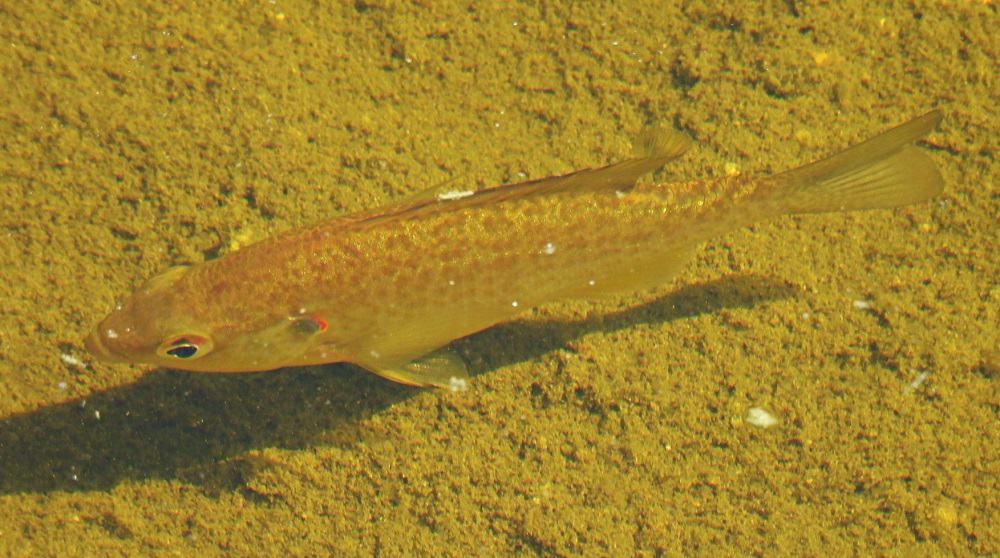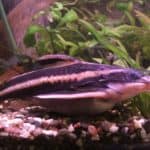Redear Sunfish are a species of tropical and temperate freshwater fish that are popular with game fishers. They are also used to manage the population of aquatic snails in ponds and lakes, as too many snails can impact the ecosystem and stunt the growth of other species of fish.
Redear Sunfish are rarely used as pets or purchased for home aquariums, but some aquarists manage to house them successfully. Other varieties of Sunfish are more popular for domestic environments due to their coloring, such as Green Sunfish or Pumpkin Seed Sunfish.

If you are considering this unusual species for your home aquarium or you want to know more about their behaviour in the wild then keep reading! We have put together a range of useful information on their diet, breeding habits, appearance and much more.
Species Summary
Redear Sunfish are endemic to the ponds, lakes, reservoirs and river drainages of the Central and Southern United States.
They have also been introduced to other areas across the country as well as South Africa, Morocco, Panama and Puerto Rico. This is because of their popularity with game fishers- they are fun to catch and tasty to eat!
Redear Sunfish tend to live in slow moving water that is at least 6.5 feet deep.
Care Guide
Tank Size
Redear Sunfish will require a minimum tank size of 50 gallons to give them enough room to swim. They prefer a deep tank, but also require enough floor space to move around as they are bottom-dwellers.
Tank Mates
There has been limited research carried out on which species make suitable tank mates for Redear Sunfish, as they are not very popular in home aquariums.
Other species of Sunfish make good tank mates, along with similar sized fish like Black Bass, Yellow Perch, and Bullheads. Avoid smaller fish as they could be attacked or eaten, and be aware that Redear Sunfish eat aquatic snails so don’t house them together if the snails are your pets!
Same Species Tanks
Redear Sunfish can live in small communities of the same species. To make them as comfortable and happy as possible you need to avoid making them feel like they are in competition for their food. Make sure you don’t create a feeding frenzy and every fish can easily access their meal.
Water Parameters
The ideal water temperature for Redear Sunfish is between 68 to 86 degrees fahrenheit. The PH level should be within 6.0 to 9.0 and the water should be fairly soft with minimal level of ammonia and nitrates.
What To Put In Their Tank
It is best to go for a fine substrate layer as these fish are bottom-dwellers and could scratch themselves on gravel. The warm, calm waters of their natural habitat have a moderate amount of plant life, and in the wild they tend to huddle around logs and plants.
Decorate the tank with driftwood and vegetation to make them feel comfortable and happy, but leave enough room for swimming.
These fish are most active at dawn and dusk and rest during the day. If you want to get the most out of them and see their activity then you may want to use subdued lighting in the tank.
Redear Sunfish do not like strong currents so try to avoid having a strong water pump that causes fast flowing water. If your pump is too strong, try angling it at the glass or placing a plant in front of it.
Common Diseases
Redear Sunfish are very resilient to disease and infection in the wild, but in a domestic environment they are susceptible to bacterial and fungal infections such as Columnaris.
If any of your fish develop an infection then you need to remove them from the main tank immediately to prevent further spread, and place them in a quarantine tank until they have completed their treatment and are fully recovered. In the meantime, you will need to clean the main tank and perform a water change.
The best way to avoid illness in your home aquarium is to maintain the correct water conditions for the fish, keep the tank clean and the water well filtered, provide the fish with a nutritious diet, and keep their stress levels as low as possible.
Stress levels can increase if the tank is incorrectly decorated with inadequate privacy, or if the fish are placed with tank mates they are not compatible with.
Food & Diet
In the wild, juvenile Redear Sunfish have to compete for insect larvae and microcrustaceans with several other species of a similar size. They also eat algae and microorganisms
Once they reach maturity and their jaws become stronger, they can begin preying on molluscs. There is an abundance of aquatic snails in their natural habitat with very few predators, so they are able to feast on this particular food with limited competition. It becomes their main source of food, switching them from an omnivorous diet to an almost exclusively carnivorous one.
It is best to feed them with live food where possible. If you want to try and get them onto frozen or pellet food then make sure you choose something that will sink to the bottom of the tank. If they try it and like it then they will likely start to eat whatever you give them.
Lifespan
The average lifespan of Redear Sunfish is around 6 years. In the wild they have been known to live for 8 years or more. If you carefully maintain the correct tank conditions then they could live in captivity for up to 7 years. A diet of live food that is high in protein will also help to prolong the life of your fish.
Appearance
Redear Sunfish have tall, narrow bodies that are green, gray or back in color. They have some red or orange markings around their opercular flap and a speckled pattern on their skin. They have larger pectoral fins than other varieties of sunfish, and their anal and dorsal fins are spiny.
Size
The average length of a Redear Sunfish in the wild is 12 inches long and they can weigh up to 2 pounds. This makes them a popular catch with game fishers. There is not much information available on how big they grow in captivity as they are not a common choice for domestic aquariums.
Behaviour & Temperament
Redear Sunfish are not nocturnal, but they tend to rest more during the day. They are most active at dawn and dusk. They like to congregate around vegetation as it makes them feel safe.
Redear Sunfish are bottom dwellers and will spend most of their time in the lower level of the tank. They will search the bottom of the tank for food, and may venture up to the middle level to swim around and explore.
Breeding
Male Redear Sunfish attract the attention of the females by making a popping sound, and by swimming in circles around their chosen female. The female will choose a male based mainly on his coloring.
The male will build a nest in the substrate, usually close to some plant life, and the females will lay eggs in multiple nests. The males will guard his nest until all the eggs have hatched – approximately 50 hours after the eggs have been fertilized.
The smallfry will hide in the substrate layer for at least 3 days, after which time they will begin free swimming. In the wild, juvenile Redear Sunfish remain close to the vegetation for protection until they are around one year old.
There have been very few occurrences of Redear Sunfish being bred in a domestic tank, as they are either bred in the wild or on large fish farms. If you want to give it a try, be aware that you might be unsuccessful. To encourage spawning in your domestic aquarium, try raising the temperature of the water a little and providing a live food diet.
Gender Differences: Male vs Female
There aren’t many differences between the sexes to help differentiate them. The main difference is in the coloring. Female Redear Sunfish have an orange margin around their opercular flap, whereas males have a red margin. Males and females have similar body shapes and grow to similar sizes.
Fun Facts
- In areas where Redear Sunfish were introduced as game fish, they have had a significant impact on the ecosystem. Other species of fish of a similar size with similar prey declined rapidly.
- Redear Sunfish are also known as Shell-crackers, Cherry gills, and Georgia Bream.
- Not only can Redear Sunfish crush the shells of aquatic snails, they have also been known to prize open clam shells.








